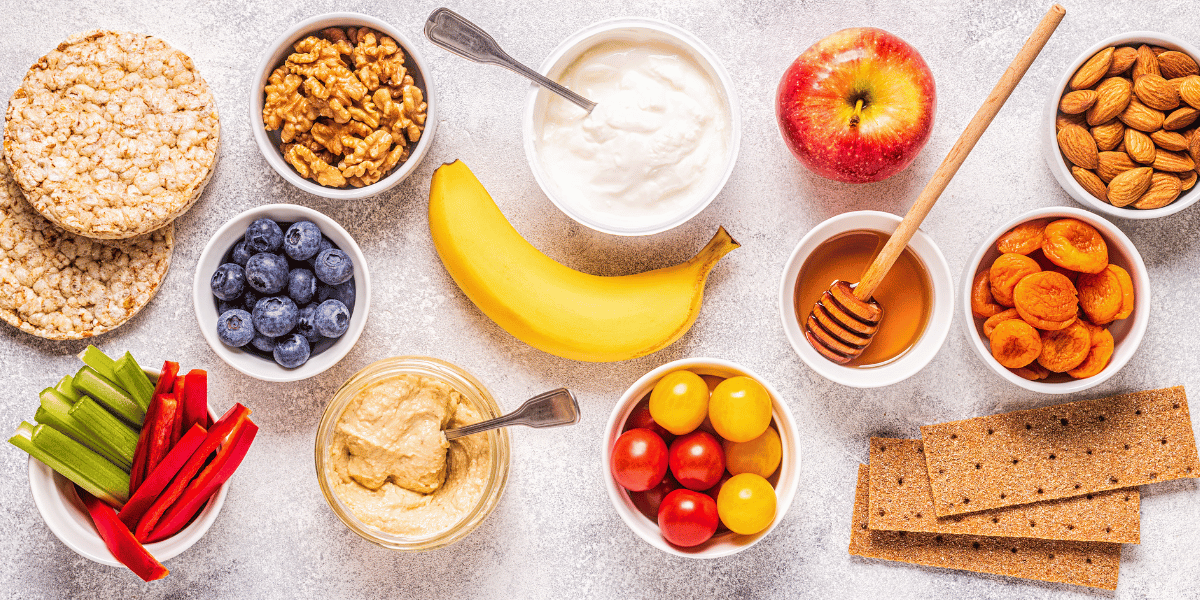The Dos and Don'ts of Snacking
Snacking has evolved from an occasional munch between meals to a ubiquitous ritual in daily routines, catering to various needs, from an energy boost...
.png?width=70&height=70&name=Stark_LogoMark%20(1).png)
The Do’s and Dont’s of Exercise
One of the most commonly asked questions when people first walk into our facilities is what should my exercises look like? While many people ask us what exercises they should be doing, we can’t provide an in-depth universal answer, as each person’s body composition and goals dictate the type of exercises or modifications they should be doing. Since we can’t jump through your screen to assess your personal fitness goals right now, we’re going to offer our universal do’s and dont’s of exercise that can act as a baseline to your training.The Seven Basic Movement Patterns
The human body has seven basic movement patterns: squat, lunge, push, pull, hinge, twist, and gate (meaning to walk or run). Take a moment to think about it — every movement you do is a combination of these seven! If you don’t use a movement pattern, you’ll lose it, so under that premise, we recommend training based on the seven movement patterns, because they are necessary for life. Here are our recommendations of specific exercises you can do for each movement:
Squat: bodyweight, kettlebell, front squat, overhead squat, and cyclists squats
Lunge: lunge, reverse lunge, split squats, and step ups
Push: bench press, push up, overhead press, single-arm dumbbell press, and using the medicine ball
Pull: pull-up, row, lat pull down, seated cable row, kneeling dumbbell row, and TRX and inverted barbell rows
Hinge: deadlift, RDLs, good mornings, and kettlebell deadlift
Twist: Russian twists, woodchops (this is a great one!)
Gate: walking, running, going up and downstairs, and hiking
Tyler and Amir’s Top Three Exercises
Tyler Mounce and Amir Mofidi each offered their top three exercises that (almost) everyone should be incorporating into their workout routine — unless there’s a justifiable medical reason not to include one! Amir’s three exercises include the following:
While Tyler agrees with Amir’s top three, he opted to offer a different three fundamental exercises you should add to your routine:
The Importance of Squats
You may not realize it — but you do squats every day! You’re doing a squat every time you get on and off the toilet, or in and out of a car seat. Further, all babies learn to stand by rising from a squat to a standing position. Squats are a fundamental human pattern that you should prioritize during your workouts.
There’s a common misconception that squatting hurts your knees. It’s actually not squatting that hurts your knees; it is squatting with improper form that will hurt your knees. Tyler Mounce says, “There are a lot of people that will likely hurt themselves doing deadlifts and squats — not because the exercises are inherently bad, but because of poor coaching, poor technique, and biomechanics.” In fact, if you do squats with the proper technique, squats can help alleviate lower back issues. Dr. Stuart M. McGill is a world-renowned spine and back expert who is a big advocate of the squat and deadlift.
While we understand that lower back issues are very common, we want to emphasize that it’s possible to squat again without any pain. If you have low back issues like a herniated disk — you can get to a point when you can squat hundreds of pounds pain-free through the process of rebuilding, restructuring, and restrengthening.
You can always begin squatting using support or without weights before progressing to other types of squats! Amir Mofidi says, “Even squatting without weight is possible. You can use support — putting your arms on an object and helping you descend into the squat. You can bend in that fashion, support your posture, and make it pain-free. Whenever I say squat or deadlift, people immediately in their minds have these images. But that’s brushing with the same stroke. That’s not what it entails. Squatting is a pattern that can be made more intense and loaded in various ways — there are many forms of squats. The pattern itself is universal.”The Dont’s
While the seven basic movement patterns are a great way to guide you when choosing which exercises to do, they should also guide you when deciding which exercises to avoid. Here’s a breakdown of what to avoid using the seven movement patterns:
Squat: don’t squat with an exaggerated curve, don’t squat with your knees buckling in toward the middle (this is how most people hurt their knees), and don’t squat on uneven ground (the idea that squatting on a rocker board will recruit more muscles is not true, you actually recruit less)
Lunge: don’t let the front foot’s heel rise, don’t keep the shin at a vertical or 90-degree angle (it’s not true that your knee shouldn’t go forward over your toes!)
Push: don’t do bench press with your legs up in the air, don’t bounce the bar off your chest, don’t lift your head off the bench when you press (keep your head in line with the rest of your spine), don’t turn your head when you do any exercise, keep the bar in front of your face and not behind your head when pressing over the head
Pull: don’t pull behind the neck, don’t do butterfly pull-ups, and don’t jet your chin forward (you should have a tucked chin!)
Hinge: don’t deadlift with a curved spine, don’t jet your head forward, don’t hyperextend, and don’t reach above parallel with back extensions
Twist: elbows should always be parallel, don’t twist from the wrong places (a lot of people flare up their back issues when twisting but not moving the hips and shoulders)
Gate: Some people shouldn’t run because of knee and hip issues! If you’re going to run, please don’t run with weight vests. We also don’t recommend running barefoot or with shoes that have too much cushioning at the bottom of the shoe. You should feel a little bit of the ground — not too much or too little!
Please keep in mind that these are universal guidelines we are offering without seeing you personally. If you have any questions or specific concerns regarding your health and fitness journey, please feel free to visit us at Stark and we’d be happy to give you more personalized guidelines.

Snacking has evolved from an occasional munch between meals to a ubiquitous ritual in daily routines, catering to various needs, from an energy boost...

The liver is one of the most vital organs in the body — it’s involved in every metabolic process. Unsurprisingly, an underperforming liver filled...